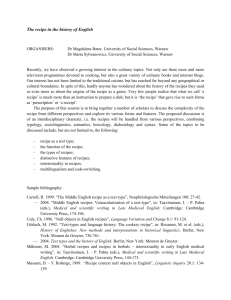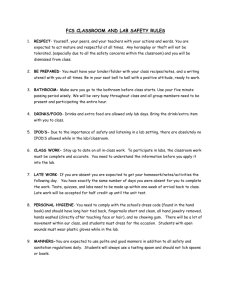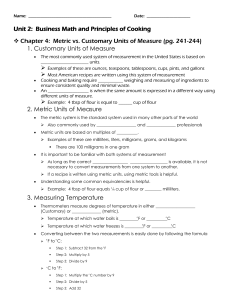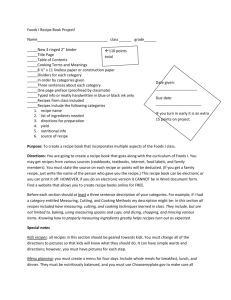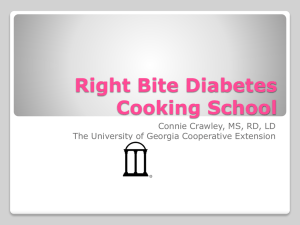SIGGRAPH2005-synaestheticrecipes
advertisement
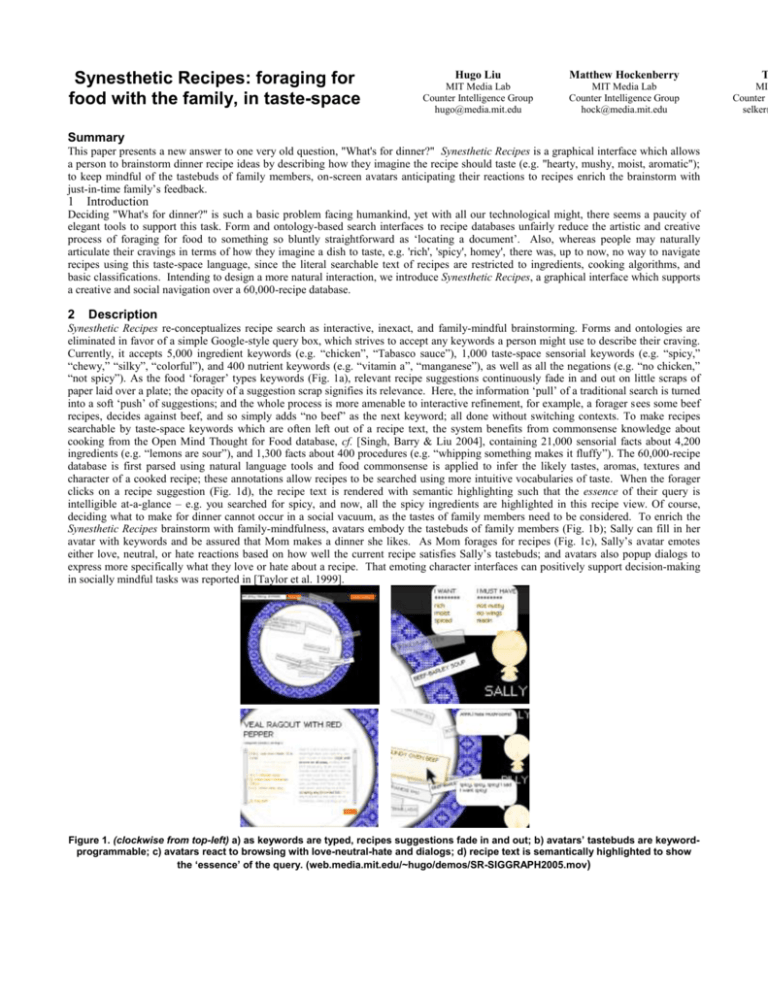
Synesthetic Recipes: foraging for food with the family, in taste-space Hugo Liu Matthew Hockenberry MIT Media Lab Counter Intelligence Group hugo@media.mit.edu MIT Media Lab Counter Intelligence Group hock@media.mit.edu Summary This paper presents a new answer to one very old question, "What's for dinner?" Synesthetic Recipes is a graphical interface which allows a person to brainstorm dinner recipe ideas by describing how they imagine the recipe should taste (e.g. "hearty, mushy, moist, aromatic"); to keep mindful of the tastebuds of family members, on-screen avatars anticipating their reactions to recipes enrich the brainstorm with just-in-time family’s feedback. 1 Introduction Deciding "What's for dinner?" is such a basic problem facing humankind, yet with all our technological might, there seems a paucity of elegant tools to support this task. Form and ontology-based search interfaces to recipe databases unfairly reduce the artistic and creative process of foraging for food to something so bluntly straightforward as ‘locating a document’. Also, whereas people may naturally articulate their cravings in terms of how they imagine a dish to taste, e.g. 'rich', 'spicy', homey', there was, up to now, no way to navigate recipes using this taste-space language, since the literal searchable text of recipes are restricted to ingredients, cooking algorithms, and basic classifications. Intending to design a more natural interaction, we introduce Synesthetic Recipes, a graphical interface which supports a creative and social navigation over a 60,000-recipe database. 2 Description Synesthetic Recipes re-conceptualizes recipe search as interactive, inexact, and family-mindful brainstorming. Forms and ontologies are eliminated in favor of a simple Google-style query box, which strives to accept any keywords a person might use to describe their craving. Currently, it accepts 5,000 ingredient keywords (e.g. “chicken”, “Tabasco sauce”), 1,000 taste-space sensorial keywords (e.g. “spicy,” “chewy,” “silky”, “colorful”), and 400 nutrient keywords (e.g. “vitamin a”, “manganese”), as well as all the negations (e.g. “no chicken,” “not spicy”). As the food ‘forager’ types keywords (Fig. 1a), relevant recipe suggestions continuously fade in and out on little scraps of paper laid over a plate; the opacity of a suggestion scrap signifies its relevance. Here, the information ‘pull’ of a traditional search is turned into a soft ‘push’ of suggestions; and the whole process is more amenable to interactive refinement, for example, a forager sees some beef recipes, decides against beef, and so simply adds “no beef” as the next keyword; all done without switching contexts. To make recipes searchable by taste-space keywords which are often left out of a recipe text, the system benefits from commonsense knowledge about cooking from the Open Mind Thought for Food database, cf. [Singh, Barry & Liu 2004], containing 21,000 sensorial facts about 4,200 ingredients (e.g. “lemons are sour”), and 1,300 facts about 400 procedures (e.g. “whipping something makes it fluffy”). The 60,000-recipe database is first parsed using natural language tools and food commonsense is applied to infer the likely tastes, aromas, textures and character of a cooked recipe; these annotations allow recipes to be searched using more intuitive vocabularies of taste. When the forager clicks on a recipe suggestion (Fig. 1d), the recipe text is rendered with semantic highlighting such that the essence of their query is intelligible at-a-glance – e.g. you searched for spicy, and now, all the spicy ingredients are highlighted in this recipe view. Of course, deciding what to make for dinner cannot occur in a social vacuum, as the tastes of family members need to be considered. To enrich the Synesthetic Recipes brainstorm with family-mindfulness, avatars embody the tastebuds of family members (Fig. 1b); Sally can fill in her avatar with keywords and be assured that Mom makes a dinner she likes. As Mom forages for recipes (Fig. 1c), Sally’s avatar emotes either love, neutral, or hate reactions based on how well the current recipe satisfies Sally’s tastebuds; and avatars also popup dialogs to express more specifically what they love or hate about a recipe. That emoting character interfaces can positively support decision-making in socially mindful tasks was reported in [Taylor et al. 1999]. Figure 1. (clockwise from top-left) a) as keywords are typed, recipes suggestions fade in and out; b) avatars’ tastebuds are keywordprogrammable; c) avatars react to browsing with love-neutral-hate and dialogs; d) recipe text is semantically highlighted to show the ‘essence’ of the query. (web.media.mit.edu/~hugo/demos/SR-SIGGRAPH2005.mov) T MIT Counter I selker@ Synesthetic Recipes is rooted in two years of research on computer representations of food, done in collaboration with Barbara Wheaton, food historian and curator of Harvard’s Schlesinger Food Library. Its earlier versions have been exhibited at several open houses of the MIT Media Lab, where hundreds of people have played with the system; many technologists, designers, mothers, and food critics have experimented with the system and contributed to its evolving design; in the near future, we hope to make the tool widely available for Mums (and Dads) everywhere. References SINGH P., BARRY B., LIU H. 2004. Teaching Machines about Everyday Life. BT Technology Journal 22(4), 227-240. Kluwer. TAYLOR I.C. ET AL. 1999. Providing animated characters with designated personality profiles. Embodied Conversational Characters, 87-92.
